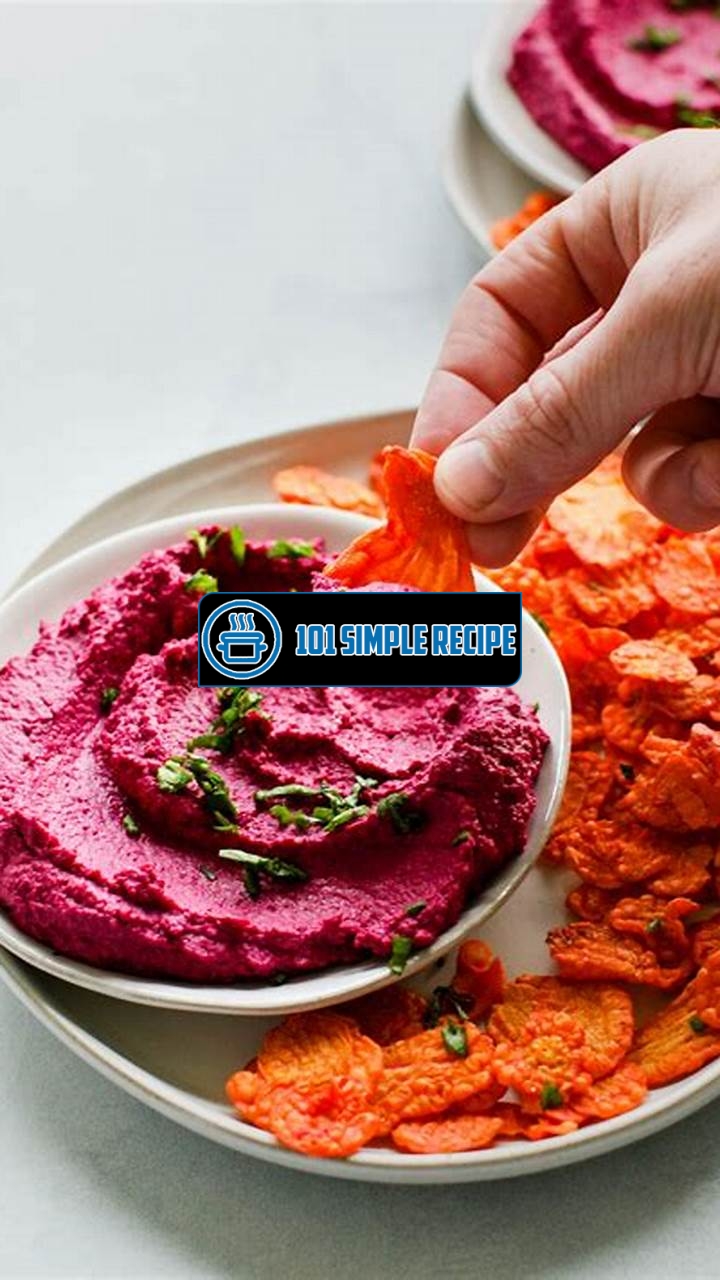If you’re craving a healthy and flavorful dip that is both easy to make and packed with nutrients, look no further than this delicious beet hummus recipe without tahini. This vibrant and colorful dip is a refreshing twist on the classic hummus, offering a unique flavor profile and an eye-catching presentation on any party platter or snack table. Made with roasted beets, chickpeas, garlic, lemon juice, and a blend of aromatic spices, this beet hummus is sure to be a hit with both beet lovers and hummus enthusiasts. And the best part? It doesn’t require tahini, making it the perfect option for those with tahini allergies or for anyone looking for a tahini-free alternative. So get ready to dip into a bowl of beet hummus goodness and enjoy a healthy snack that’s as fulfilling as it is satisfying! ️

Introduction to Beet Hummus Recipe without Tahini
Discover how to make a delicious and nutritious beet hummus without the traditional addition of tahini. This satisfying and vibrant dip is perfect for parties, picnics, or as a healthy snack option. With its stunning deep red color, beet hummus adds a pop of color to any table spread. Plus, it’s incredibly easy to prepare!
The Health Benefits of Beet Hummus
Beet hummus is not only delicious but also packed with health benefits. Beets are known for their high nutritional value and are a great source of minerals such as potassium, iron, and magnesium. They also contain essential vitamins like vitamin C and folate. Additionally, beets are rich in dietary fiber, which aids digestion and helps maintain a healthy weight.
Consuming beet hummus can contribute to better heart health. Beetroots are known to lower blood pressure and improve blood flow due to their high nitrate content. Nitrate is converted into nitric oxide in the body, which helps dilate blood vessels and lower the risk of cardiovascular diseases.
Furthermore, beets are packed with antioxidants that help combat oxidative stress and inflammation in the body. These antioxidants, like betalains, contribute to a strong immune system and have anti-cancer properties.
Lastly, beet hummus is a fantastic option for those following a plant-based or vegan diet. It provides a good amount of protein, healthy fats, and essential amino acids, making it a nutritious choice for individuals looking to increase their protein intake from non-animal sources.
Why Skip the Tahini?
Traditionally, hummus is made with tahini, a sesame seed paste. However, there are several reasons why you might want to skip the tahini when making beet hummus.
Firstly, tahini has a distinct flavor that may overpower the delicate sweetness of the beets. By omitting tahini from the recipe, you allow the earthy and slightly sweet flavor of the beets to shine through. This results in a more vibrant and unique beet hummus that stands out from the traditional version.
Secondly, tahini is high in fat and calories. If you are watching your fat intake or trying to manage your calorie consumption, omitting tahini from the recipe can help reduce the overall calorie content without compromising taste or texture.
Last but not least, by excluding tahini, you also make the beet hummus suitable for those with sesame allergies or intolerances. This allows more people to enjoy the deliciousness of beet hummus without any worries.
Substitutes for Tahini in Beet Hummus
If you decide to skip tahini in your beet hummus recipe, there are several tasty substitutes you can use to maintain a creamy texture and enhance the flavor.
One popular alternative is using Greek yogurt or plain yogurt. Yogurt adds a tangy flavor and a creamy consistency to the hummus. It also boosts the protein content, making the dip more satisfying.
Another option is using avocado as a substitute for tahini. Avocado adds a smooth and velvety texture while providing healthy fats and essential nutrients. It brings a subtle nutty flavor to the hummus, complementing the beets perfectly.
If you prefer a nut-free option, you can substitute tahini with sunflower seed butter or almond butter. These spreads add richness and creaminess to the beet hummus. Just make sure to use unsweetened varieties.
In conclusion, beet hummus without tahini is a delicious and nutritious alternative to the traditional recipe. It offers a unique flavor profile and provides numerous health benefits, such as improved heart health and strong immune support. By skipping tahini, you can enjoy a lighter and allergen-friendly version of this vibrant dip. Experiment with different substitutes to find your favorite combination and indulge in the goodness of beet hummus!
Choosing the Right Beets
When it comes to making delicious beet hummus without tahini, selecting the right beets is key. The freshness and flavor of the beets will greatly impact the taste of your hummus. Here are some tips to help you choose the best beets for your recipe.
Farmers Market or Grocery Store?
When it comes to buying beets, you have two main options: the farmers market or the grocery store. Both options have their pros and cons, so it really depends on your personal preferences.
Farmers Market: The farmers market is a great place to find fresh, locally grown beets. This option allows you to support local farmers and often provides a wider variety of beet options. Plus, you can ask the farmers for recommendations on the best beets for making hummus.
Grocery Store: If you don’t have access to a farmers market or prefer the convenience of a grocery store, you can still find good quality beets. Look for beets that are firm, with smooth skin and vibrant color. Avoid beets that are soft or have wrinkled skin, as these may be older and less flavorful.
Prepping and Cooking the Beets
Once you’ve selected your beets, it’s time to prep and cook them. Here’s a step-by-step guide to help you get the best results:
- Trim and wash: Start by trimming off the greens and any long roots from the beets. Then, give them a thorough wash to remove any dirt or debris.
- Boil or roast: There are two popular methods for cooking beets – boiling or roasting. Boiling is a quicker method, while roasting can enhance the natural sweetness of the beets. Choose the method that suits your taste and time constraints.
- Boiling: To boil the beets, place them in a pot of water and bring to a boil. Cook for about 30-40 minutes, or until the beets are tender when pierced with a fork.
- Roasting: To roast the beets, preheat your oven to 400°F (200°C). Wrap each beet in foil and place on a baking sheet. Roast for about 45-60 minutes, or until the beets are easily pierced with a fork.
Note: Roasting the beets can enhance their natural sweetness and add a depth of flavor to your hummus.
Peel or No Peel?
Once the beets are cooked and cooled, you’ll need to decide whether to peel them or leave the skin on. This is strictly a matter of personal preference, as both options can create delicious beet hummus.
Peel: If you prefer a smoother and more vibrant hummus, peeling the beets is the way to go. To peel the beets, simply use your fingers or a paring knife to remove the skin. The cooked beets should easily slide out of their skin.
No Peel: Leaving the skin on the beets can add a rustic and earthy flavor to your hummus. Plus, it saves you time and effort in the kitchen. Just ensure that the beets are thoroughly washed and free of any dirt or debris before blending them.
Now that you know how to choose, prep, and cook your beets, you’re ready to make a delicious beet hummus without tahini. Get creative with your flavors and enjoy this nutritious and vibrant dip!
The Perfect Blending Techniques
When it comes to preparing a delicious beet hummus without tahini, mastering the art of blending is essential. The right blending techniques can help you achieve a smooth and creamy texture, making your hummus irresistible. Here are some key tips to keep in mind:
Blender vs. Food Processor
Both blenders and food processors can be used to make beet hummus, but each appliance has its own advantages and considerations. Blenders are best for creating a smoother and creamier texture, as they can break down the ingredients more efficiently. On the other hand, food processors are great for making chunkier, more textured hummus. Consider the consistency you prefer and choose the appliance accordingly.
⭐️ Tip: If you want a super-smooth hummus, opt for a blender.
Adding Liquid Ingredients
One of the secrets to achieving the perfect texture in your beet hummus is carefully adding liquid ingredients. Start by adding small amounts of liquid, such as olive oil or lemon juice, while blending. This helps the ingredients blend together smoothly and creates a creamy consistency.
⭐️ Tip: Add the liquid gradually and adjust according to your desired thickness.
Balancing Flavors
Creating a well-balanced and flavorful beet hummus without tahini is all about finding the right combination of ingredients. Along with the beets, which provide a unique earthy taste, consider adding other flavor-enhancing ingredients such as garlic, cumin, or smoked paprika.
⭐️ Tip: Experiment with different herbs and spices to customize the flavors to your liking.
Remember, mastering the blending techniques, choosing the right appliance, adding liquid ingredients gradually, and balancing flavors are all crucial steps to creating a delicious beet hummus without tahini. With a little practice and creativity, you will be able to enjoy a creamy and flavorful dip that will impress your guests and tantalize your taste buds.
Enhancing the Flavor Profile
When it comes to beet hummus, the flavor profile can sometimes fall flat without the addition of tahini. However, fear not! There are numerous creative ways to amp up the taste of your beet hummus and make it truly delicious without relying on tahini. In this article, we will explore three key methods for enhancing the flavor profile of your beet hummus.
Spices and Seasonings
One way to add a burst of flavor to your beet hummus is by incorporating various spices and seasonings. These ingredients not only enhance the taste but also infuse the hummus with a delightful aroma. Consider adding cumin, paprika, and a pinch of cayenne pepper to give your beet hummus a subtle smoky kick. Additionally, a touch of ground coriander can lend a refreshing and zesty note. Remember, the key is to start with small amounts and adjust the seasonings according to your personal preference.
✨ Pro tip: Experiment with different spice combinations to create a unique flavor profile that suits your taste buds.
Herbs and Citrus Zest
An easy way to elevate the taste of your beet hummus is by incorporating fresh herbs and citrus zest. Chopped parsley, cilantro, or mint can add a vibrant herbal note to balance out the earthiness of the beets. Additionally, try incorporating some freshly grated lemon or orange zest for a bright and citrusy twist. These small additions can make a huge difference in the overall flavor of your beet hummus.
✨ Pro tip: Don’t be afraid to get creative with different herb combinations to find your favorite flavor profile.
Roasted Garlic and Onion
The final method for enhancing the flavor profile of your beet hummus is by adding roasted garlic and onion. Roasting these ingredients brings out their natural sweetness and adds a rich depth of flavor to the hummus. Simply coat whole garlic cloves and onion slices with olive oil, season with salt and pepper, and roast them in the oven until caramelized. Once cooled, blend them with the beet hummus for a truly delectable taste.
✨ Pro tip: Roast a larger batch of garlic and onion to have extra for future beet hummus or other recipes.
By utilizing these creative methods for enhancing the flavor profile of your beet hummus, you can create a tantalizing dip that is sure to impress. Experiment with different combinations of spices, herbs, and roasted vegetables to find your perfect balance of flavors. So go ahead, ditch the tahini and embark on a flavor journey with your homemade beet hummus!
Serving and Pairing Ideas
When it comes to enjoying your delectable beet hummus, the serving and pairing options are truly endless. Whether you are hosting a gathering or simply treating yourself to a flavorful snack, exploring various serving and pairing suggestions can help elevate your beet hummus experience.
Creative Dip Combinations
One way to add excitement to your beet hummus is by pairing it with an array of creative and delicious dips. Think outside the box and consider unconventional combinations such as:
- Roasted Red Pepper Dip ️: The smoky undertones of roasted red pepper dip complement the earthy flavors of beet hummus perfectly.
- Pesto Dip : The fresh and aromatic flavors of pesto provide a delightful contrast to the sweetness of beet hummus.
- Spicy Sriracha Dip : If you enjoy a hint of heat, pairing your beet hummus with a spicy sriracha dip will give your taste buds a fiery kick.
By experimenting with different dip combinations, you can create a personalized and exciting tasting journey.
Using Beet Hummus in Sandwiches and Wraps
Another fantastic way to incorporate beet hummus into your meals is by using it as a flavorful spread in sandwiches and wraps. The rich color and savory taste of beet hummus can transform an ordinary sandwich into a vibrant and nutritious delight. Here are some creative ideas:
- Roasted Veggie Wrap : Layer your favorite roasted vegetables, such as bell peppers, zucchini, and eggplant, with beet hummus for a satisfying and nutritious wrap.
- Grilled Chicken Sandwich : Slather some beet hummus onto a grilled chicken breast, then top it with lettuce, tomato, and pickles for a wholesome and flavorful sandwich.
- Caprese Panini : Spread beet hummus on fresh ciabatta bread, and add mozzarella cheese, sliced tomatoes, and basil leaves. Grill the panini to perfection for a mouthwatering vegetarian option.
Adding beet hummus to your sandwiches and wraps not only enhances the taste but also provides an extra dose of nutrients.
Serving as a Vibrant Side Dish
In addition to being a fabulous dip and spread, beet hummus can also shine as a vibrant side dish. It beautifully complements a variety of main courses and adds a pop of color to your plate. Consider these ideas:
- Grilled Salmon with Beet Hummus : Serve a perfectly grilled salmon fillet on a bed of beet hummus garnished with fresh dill and lemon wedges.
- Roasted Lamb Chops with Beet Hummus : Pair your succulent roasted lamb chops with a generous dollop of beet hummus for a combination that will impress your guests.
- Vegetable Skewers with Beet Hummus : Thread your favorite vegetables onto skewers, grill them to perfection, and serve alongside a bowl of vibrant beet hummus.
Whether you’re grilling, roasting, or serving vegetarian options, adding beet hummus as a side dish will elevate your culinary creations to a whole new level.
With these serving and pairing ideas, you can unlock the full potential of beet hummus and take your taste buds on an exciting journey. Whether you prefer to explore creative dip combinations, use it as a spread in sandwiches and wraps, or serve it as a vibrant side dish, beet hummus without tahini will surely delight your senses.
Frequently Asked Questions
Thank you for reading our article about beet hummus recipe without tahini! Here are some frequently asked questions:
| No. | Questions | Answers |
|---|---|---|
| 1. | Can I substitute tahini with another ingredient? | Yes, you can substitute tahini with Greek yogurt or almond butter for a different flavor. |
| 2. | How long does beet hummus last in the refrigerator? | Beet hummus can be stored in the refrigerator for up to 5 days. |
| 3. | Can I freeze beet hummus? | Yes, you can freeze beet hummus for up to 3 months. Thaw it in the refrigerator before using. |
| 4. | What are some serving suggestions for beet hummus? | Beet hummus can be enjoyed as a dip with pita bread, carrot sticks, or cucumber slices. You can also use it as a spread in sandwiches or wraps. |
| 5. | Can I customize the flavor of beet hummus? | Yes, you can add extra ingredients like garlic, lemon juice, or cumin to customize the flavor of beet hummus. |
| 6. | Is beet hummus a healthy snack option? | Yes, beet hummus is a nutritious snack as it contains fiber, vitamins, and minerals. It is also a great source of plant-based protein. |
Thank You for Reading!
We hope you enjoyed learning about the beet hummus recipe without tahini. You now have a delicious and versatile dip that you can enjoy with various meals or as a healthy snack. Don’t forget to bookmark our website and visit again for more tasty recipes and cooking tips. Happy cooking!
Jump to Recipe
Beet Hummus Recipe without Tahini

Learn how to make a delicious beet hummus without tahini. This creamy and vibrant dip is packed with flavor and nutrients, making it a perfect healthy snack or appetizer. It’s also a great option for those with tahini allergies or preferences.
- 2 medium beets (cooked and peeled)
- 1 can (15 oz chickpeas, drained and rinsed)
- 2 cloves garlic
- 3 tablespoons lemon juice
- 2 tablespoons olive oil
- 1 teaspoon ground cumin
- Salt and pepper to taste
- In a food processor, combine the cooked beets, chickpeas, garlic, lemon juice, olive oil, cumin, salt, and pepper.
- Process until smooth and creamy, scraping down the sides as needed.
- Taste and adjust the seasoning if needed.
- Transfer the beet hummus to a serving bowl and garnish with a drizzle of olive oil, sesame seeds, and fresh herbs.
- Serve with pita bread, carrot sticks, or cucumber slices.
- Enjoy!






